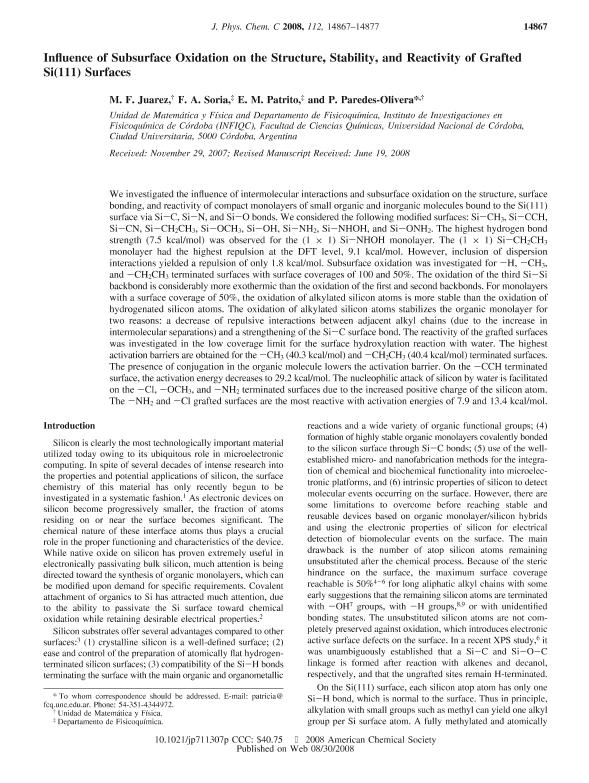Artículo
Influence of subsurface oxidation on the structure, stability, and reactivity of grafted Si(111) surfaces
Juarez, Maria Fernanda ; Soria, Federico Ariel
; Soria, Federico Ariel ; Patrito, Eduardo Martin
; Patrito, Eduardo Martin ; Paredes Olivera, Patricia
; Paredes Olivera, Patricia
 ; Soria, Federico Ariel
; Soria, Federico Ariel ; Patrito, Eduardo Martin
; Patrito, Eduardo Martin ; Paredes Olivera, Patricia
; Paredes Olivera, Patricia
Fecha de publicación:
09/2008
Editorial:
American Chemical Society
Revista:
Journal of Physical Chemistry C
ISSN:
1932-7447
e-ISSN:
1932-7455
Idioma:
Inglés
Tipo de recurso:
Artículo publicado
Clasificación temática:
Resumen
We investigated the influence of intermolecular interactions and subsurface oxidation on the structure, surface bonding, and reactivity of compact monolayers of small organic and inorganic molecules bound to the Si(111) surface via Si-C, Si-N, and Si-O bonds. We considered the following modified surfaces: Si-CH3, Si-CCH, Si-CN, Si-CH2CH3, Si-OCH 3, Si-OH, Si-NH2, Si-NHOH, and Si-ONH2. The highest hydrogen bond strength (7.5 kcal/mol) was observed for the (1 × 1) Si-NHOH monolayer. The (1 × 1) Si-CH2CH3 monolayer had the highest repulsion at the DFT level, 9.1 kcal/mol. However, inclusion of dispersion interactions yielded a repulsion of only 1.8 kcal/mol. Subsurface oxidation was investigated for -H, -CH3, and -CH2CH 3 terminated surfaces with surface coverages of 100 and 50%. The oxidation of the third Si-Si backbond is considerably more exothermic than me oxidation of the first and second backbonds. For monolayers with a surface coverage of 50%, the oxidation of alkylated silicon atoms is more stable than the oxidation of hydrogenated silicon atoms. The oxidation of alkylated silicon atoms stabilizes the organic monolayer for two reasons: a decrease of repulsive interactions between adjacent alkyl chains (due to the increase in intermolecular separations) and a strengmening of the Si-C surface bond. The reactivity of the grafted surfaces was investigated in the low coverage limit for the surface hydroxylation reaction with water. The highest activation barriers are obtained for the -CH3 (40.3 kcal/mol) and -CH 2CH3 (40.4 kcal/mol) terminated surfaces. The presence of conjugation in the organic molecule lowers the activation barrier. On the -CCH terminated surface, the activation energy decreases to 29.2 kcal/mol. The nucleophilic attack of silicon by water is facilitated on the -Cl, -OCH 3, and -NH2 terminated surfaces due to the increased positive charge of the silicon atom. The -NH2 and -Cl grafted surfaces are the most reactive with activation energies of 7.9 and 13.4 kcal/mol.
Palabras clave:
Silicon
,
Subsurface Oxidation
,
Surface Modification
,
Ab Initio
Archivos asociados
Licencia
Identificadores
Colecciones
Articulos(INFIQC)
Articulos de INST.DE INVESTIGACIONES EN FISICO- QUIMICA DE CORDOBA
Articulos de INST.DE INVESTIGACIONES EN FISICO- QUIMICA DE CORDOBA
Citación
Juarez, Maria Fernanda; Soria, Federico Ariel; Patrito, Eduardo Martin; Paredes Olivera, Patricia; Influence of subsurface oxidation on the structure, stability, and reactivity of grafted Si(111) surfaces; American Chemical Society; Journal of Physical Chemistry C; 112; 38; 9-2008; 14867-14877
Compartir
Altmétricas



